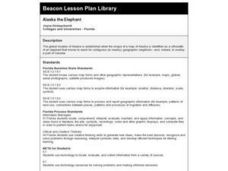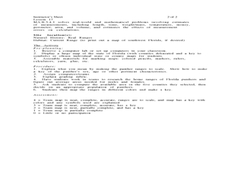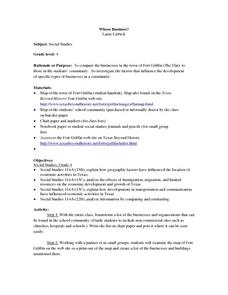Curated OER
Cartographer and Journalish as Storytellers
Students collaborate in groups of four students to create a written description of their community during a specific year. They analyze data provided by maps and newspaper articles. They meet as a whole class to discuss their conclusions.
Curated OER
What Do We Do About Dues?
Learners analyze whether the U.S. should pay dues to the United Nations. They discuss the purposes of the U.N., conduct Internet research on the U.N. website, and summarize the activities and accomplishments of one of the U.N. agencies.
Curated OER
Too Many People Coming a Little Too Fast
Students learn what happens when a city's population grows too rapidly for the city to accommodate it. They examine and discuss examples of cities growing rapidly today, what problems occur with rapid growth, and ways to solve these...
Curated OER
Metropolitan Areas in the USA
Fifth graders explore why people live in certain regions of the United States. They investigate information on specific metropolitan areas such as temperature, population, natural resources, precipitation and landforms. In groups, 5th...
Curated OER
Rivers And Capitals
Students become familiar with the use of GIS for research and become aware of the importance of rivers to cities. They also analyze the placement of cities and learn the names of rivers in the United States.
Curated OER
Got Park? Or if you build it, they will come!
High schoolers use GIS and GPS technology to evaluate, research, locate, and recommend where a new park should be located that benefit the community.
Curated OER
How We Get From Here to There
Students recognize various types of movement people rely on to get from one place to another, locate the forms of movement on a map and choose one form of movement and research its path.
Curated OER
America's Civil Rights Movement, Activity Four
Pupils investigate the concept that people died during the Civil Right;s Movement using the Matix method.
Curated OER
Alaska the Elephant
Students explore an Internet website, locating and matching the shape of an elephant's head to a state in the U.S. They complete an Alaska worksheet, identifying other geographical locations surrounding Alaska.
Curated OER
A Geopoem About Alaska
Sixth graders conduct Internet research on the physical and human characteristics of Alaska. They compose and write geopoems about the state of Alaska, using a template.
Curated OER
Site vs. Situation: Location! Location! Location!
Students examine places with a similar latitude to Alabama, and discuss the importance of a location's site versus its situation. They analyze maps, create a chart, and write a paragraph on the difference between site and situation.
Curated OER
Lesson 1: Design a Transportation Stamp
Students, in groups, research a certain form of transportation that has affected Maine's economic and cultural development. They write a persuasive letter that uses the research to support an argument.
Curated OER
How Are Boundaries Made, Kept, Broken?
Students perform raps and analyze issues among the rich and poor. They explore how countries are labeled as "third world" and "first world." They create a dialectical journal and examine the country of Nigeria through the reading of...
Curated OER
How Are Boundaries Made, Kept, Broken?
Students examine the works of Noam Chomsky. They collaborate in small groups to read and identify vocabulary words and historical questions. They answer their questions and role-play as emissaries to locate remaining answers. They...
Curated OER
Alaska Trade
Students spend two days traveling throughout Alaska, trading as they go. They explore universal principles related to trade and commerce while studying about Alaska's geography and indigenous people. At the end of the lesson plan,...
Curated OER
Home on the Range
Young scholars use maps and mathematics to determine the appropriate panther population in a given area. In this Florida ecology lesson, students research the area requirements of male and female panther and use a map to help calculate...
Curated OER
Whose Business?
Fourth graders compare and contrast the businesses in Fort Griffin with those in their own community. Using the internet, they discover the factors that have influenced the development of businesses in a town. They also create a map of...
Curated OER
Passport to the Eastern Hemisphere
Seventh graders create a time line of significant dates in the history of their nation. This requires students to examine the entire history of a country and make informed judgments based on their historical knowledge.
Curated OER
Traveling Along the Indiana Underground Railroad
Students develop a deeper understanding of the role that Indiana played in the Underground Railroad while exploring Indiana Geography.
Curated OER
Can You Do It? I Can Do It!
Students imitate the same movements that different animals would make.
Curated OER
Civil Rights and the ADA
Students examine and discuss the 14th and 15th amentments, and evaluate the agendas of Americans from underrepresented groups in the quest for civil rights. They conduct Internet research and create essays or posters regarding Civil Rights.
Curated OER
Metalling in Around the World
Third graders explore the important leaders in different cultures by researching coinage. Through this process, they also recognize the cultural universality on coinage and currency.
Curated OER
Growing Pains of the Yearling
Fourth graders read The Yearling by Marjorie Kinnan Rawlings.
Curated OER
The Revolving Door: U.S. Immigration
Learners compare current cultural perceptions of the immigrant experience with ones of the past. They will relate current immigration stories as seen in the PBS documentary "The New Americans" to those of the historical past.
Other popular searches
- Whale Migration Patterns
- Human Migration Patterns
- Bird Migration Patterns
- Animal Migration Patterns
- Canada Migration Patterns
- Animals Migration Patterns
- Migration Patterns in Us
- Butterfly Migration Patterns
- Global Migration Patterns























